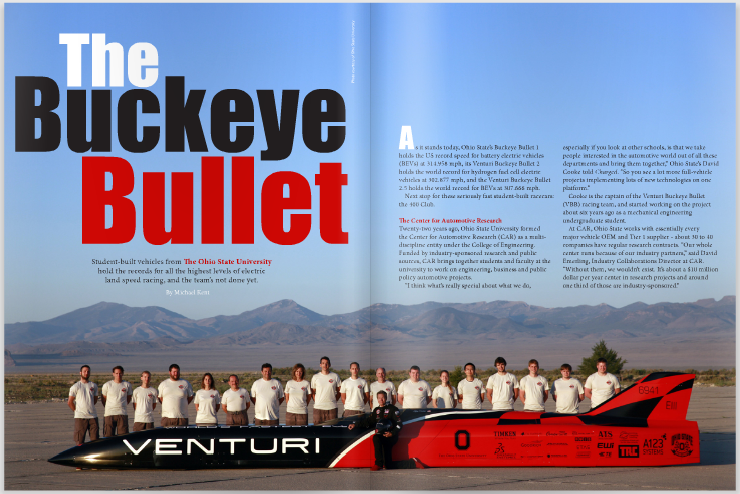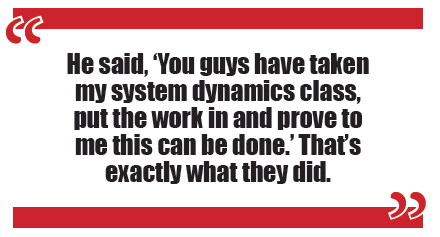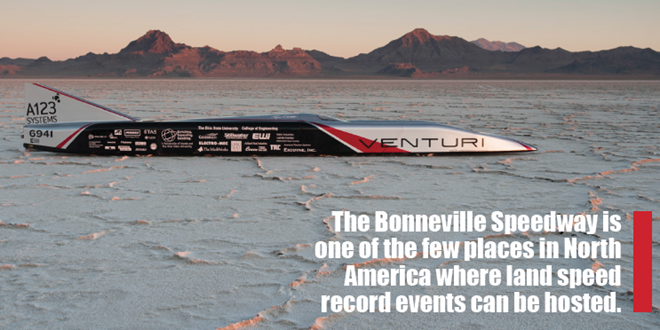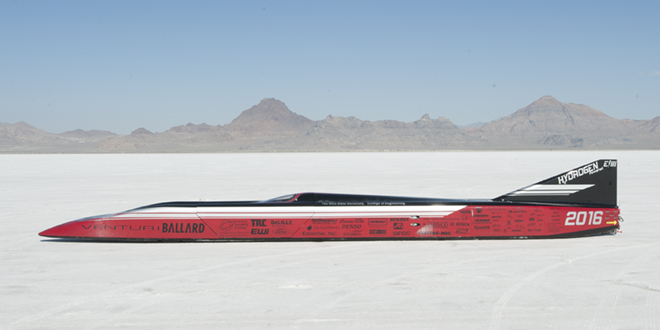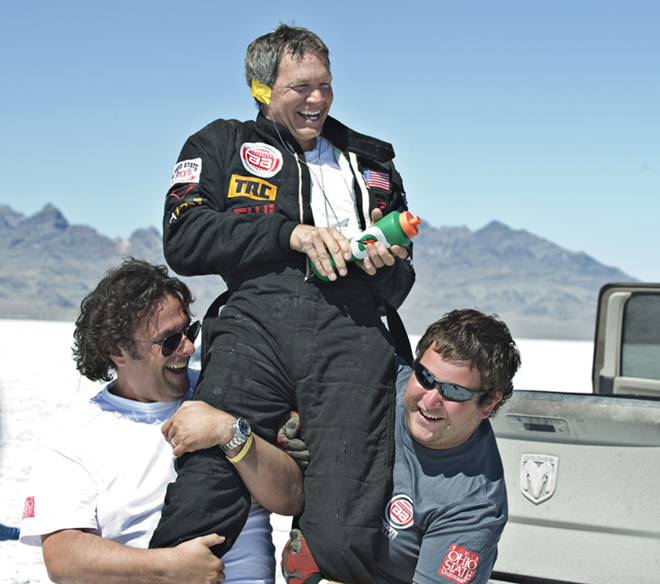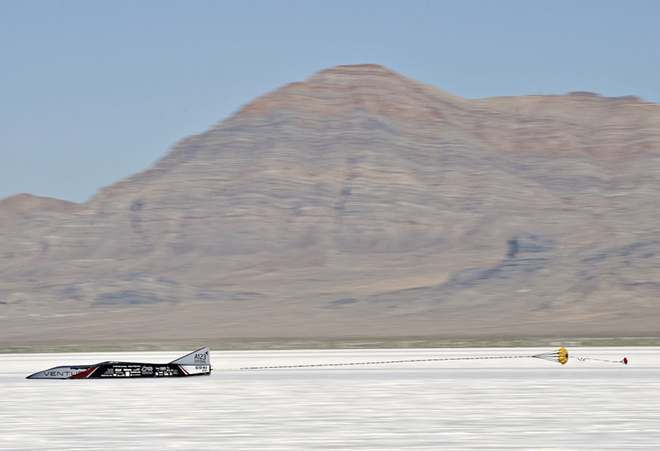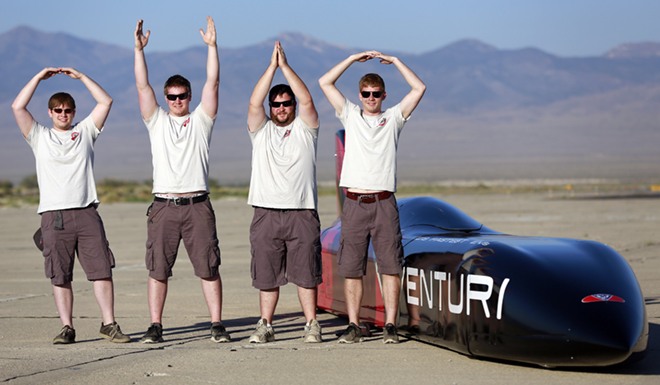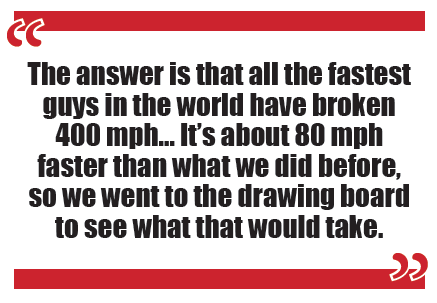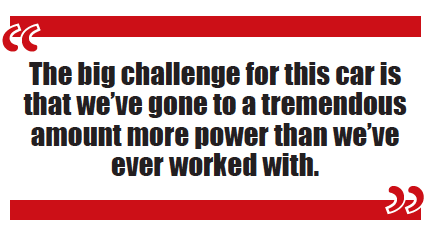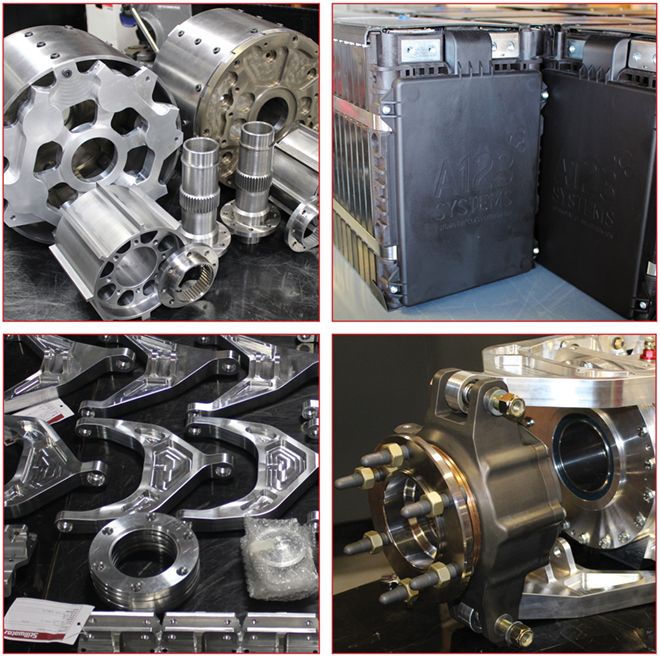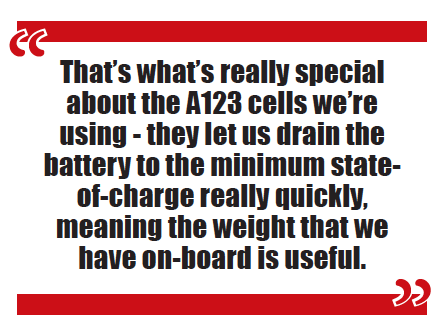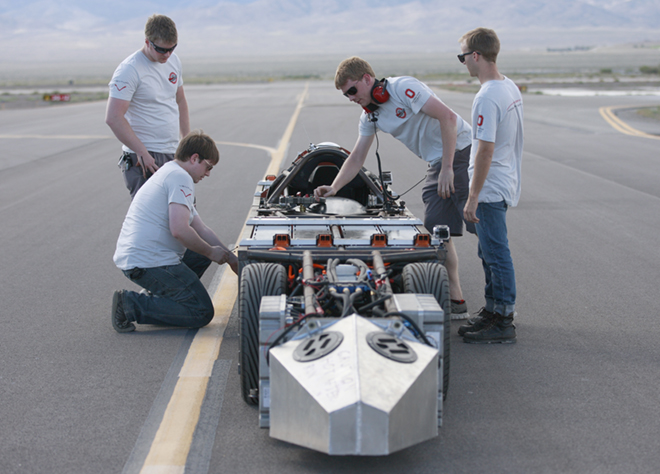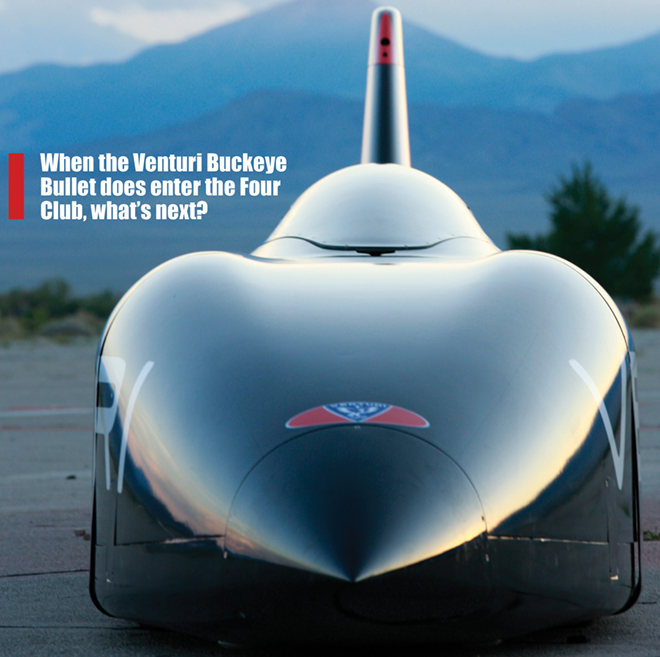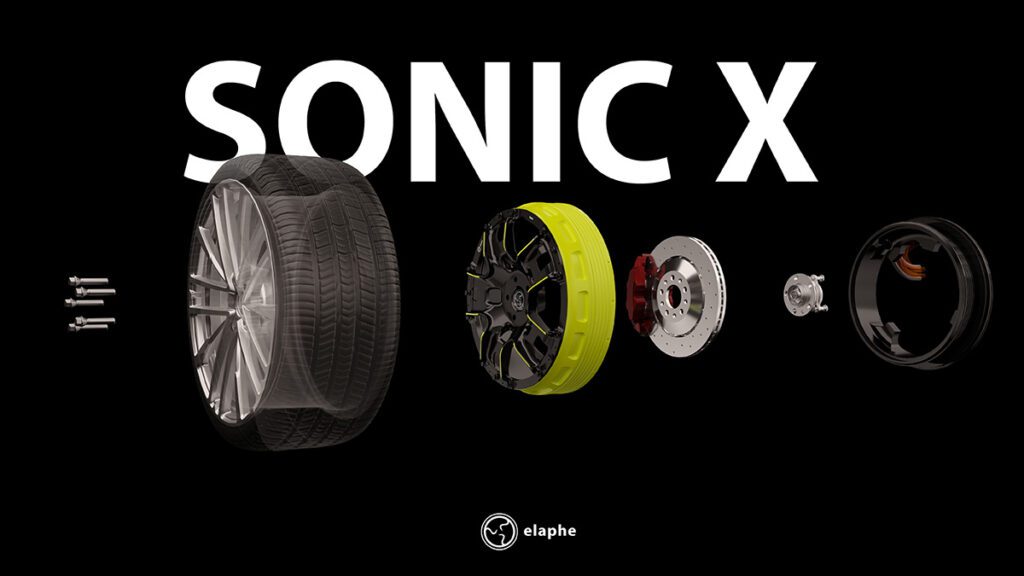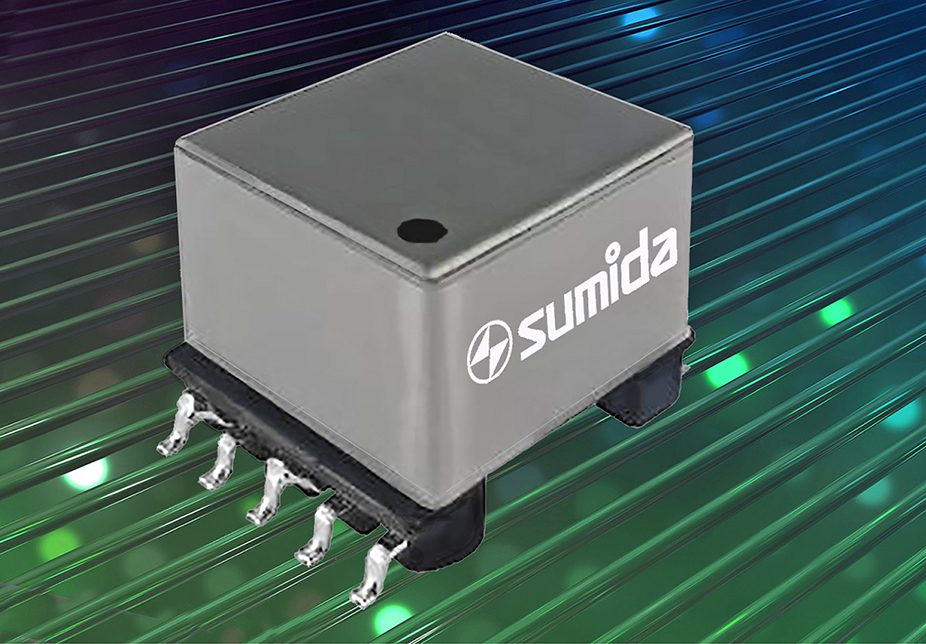As it stands today, Ohio State’s Buckeye Bullet 1 holds the US record speed for battery electric vehicles (BEVs) at 314.958 mph, its Venturi Buckeye Bullet 2 holds the world record for hydrogen fuel cell electric vehicles at 302.877 mph, and the Venturi Buckeye Bullet 2.5 holds the world record for BEVs at 307.666 mph.
Next stop for these seriously fast student-built racecars: the 400 Club.
The Center for Automotive Research
Twenty-two years ago, Ohio State University formed the Center for Automotive Research (CAR) as a multi-discipline entity under the College of Engineering. Funded by industry-sponsored research and public sources, CAR brings together students and faculty at the university to work on engineering, business and public policy automotive projects.
“I think what’s really special about what we do, especially if you look at other schools, is that we take people interested in the automotive world out of all these departments and bring them together,” Ohio State’s David Cooke told Charged. “So you see a lot more full-vehicle projects implementing lots of new technologies on one platform.”
Cooke is the captain of the Venturi Buckeye Bullet (VBB) racing team, and started working on the project about six years ago as a mechanical engineering undergraduate student.
At CAR, Ohio State works with essentially every major vehicle OEM and Tier 1 supplier – about 30 to 40 companies have regular research contracts. “Our whole center runs because of our industry partners,” said David Emerling, Industry Collaborations Director at CAR. “Without them, we wouldn’t exist. It’s about a $10 million dollar per year center in research projects and around one third of those are industry-sponsored.”
The motorsport-research connection
Ohio State’s motorsport projects – like the Buckeye Bullet program – are essentially after-school clubs. They’re something students get involved in because they want to. However, these clubs are co-located at CAR, which leads to a lot of industrial partnerships, research questions and new projects that develop out of these “hobby” racing activities.
“CAR holds its advisory board meeting with research partners every six months, and at that time we always present what’s going on in our motorsport projects,” said Cooke. “Some people who attend these meetings are pretty high up in engineering design management at different companies. For example, once I ended up at a table with Abe Shocket, who is an engineering director at TE Connectivity. He asked what we were using for high-voltage connections and contactors on the VBB. I told him we were having trouble finding a good solution, and he offered to help. So, that’s a huge benefit to co-location. The primary product of the teams is students – and a lot of students who work on the motorsport projects eventually end up doing graduate work for these companies.”
Electric achievements
The history of electric racing at Ohio State dates back over two decades to a competitive collegiate series called Formula Lightning in 1993. The cars were open-wheel spec chassis, powered by 31 lead-acid batteries. About 20 universities participated, and Ohio State was able to establish a pretty early dominance. “They won every national championship that the series had,” said Cooke. “There were three years when the series had a season-long national points championship and Ohio State has all of those trophies.”
In about the year 2000, interest in that series dwindled. Lead-acid tech hadn’t really improved much, so the races were really short. When some of the main sponsors pulled out, the series fell apart.
At Ohio State, the group of student research engineers decided to go in a different direction. As the story goes, at the goodbye dinner with the sponsors from the formula series, a representative from the motor manufacturer asked, “How fast has an electric car gone?” That question is what started everything Ohio State has done for the last 14 years.
The students began to look at what the performance envelope was on an EV, and found that at that time it was about 245 mph. The group took their mathematical-model knowledge and built computer simulations to estimate what it would take to beat that record. They took the results to Dr Giorgio Rizzoni, an up-and-coming professor at the time who is now the director of CAR. “He will tell you that he was hesitant when they first came to him,” explains Cooke. “He said, ‘You guys have taken my system dynamics class, put the work in and prove to me this can be done.’ That’s exactly what they did. The team stayed on him and proved the engineering case until he came in full support of it. That’s when they decided to go after the land speed record for EVs.”
Land speed racing
The basic concept of land speed racing is a lot like drag racing, except that the track is much longer, and vehicles race one at a time. There is no single organization for validation and regulation, and hundreds of classes exist based on things like engine size, levels of power, fuel type, whether the vehicle is production or custom, etc.
Records are standardized as the speed over a course of fixed length. In general, there is about five to six miles of acceleration, then each pass is timed over a mile and the average is taken for two attempts in opposite directions within one hour. A new record must exceed the previous one by at least one percent to be validated.
The Bonneville Speedway – an area near Wendover, Utah – is one of the few places in North America where land speed record events can be hosted. It’s a dried-up lake bed that floods every winter. When the water dries in the summer, a very flat and tightly-packed salt surface is revealed. It’s a huge area that covers about 50 square miles, perfect for attempting to drive hundreds of miles per hour.
At Bonneville, there are a couple big racing events each year. The one that is the most well-known is Speed Week, usually in August, where racers attempt to break US records (world records are regulated separately). At Speed Week there are many different vehicles – mostly gas-powered – including bicycles, motorcycles, semi-trucks, production cars, streamliners (the category the VBB competes in) and others.
BB1
The first iteration of the Buckeye Bullet (BB1) was developed in the early 2000s. Powered by nickel-metal hydride batteries, it set the US land speed record in 2004 at 314.958 mph. “That was the first attempt at a car. It did the job and was an amazing thing to do,” said Cooke. “But there was a lot learned – like the first time you do anything, there are a thousand things you want to do differently.”
In 2005, the team started discussing what to do next, and decided that BB1 was not safe to go any faster. It was designed for 300 mph, and at 315 mph they were starting to see signs that the vehicle had reached its limits. It was pushing the limitations of the tires, and it started to have problems with parachute deployment at high speeds because of the aerodynamics of the vehicle. So, they decided it was time to retire the BB1 and began to discuss how to power the next iteration of the vehicle.
Nickel-metal hydride battery technology had not advanced very much, so they looked elsewhere. Lithium-ion batteries started to pop up in consumer electronics, but they were very new, only available in small form factors and incredibly expensive. The team didn’t think it was realistic to try to power the next race car with Li-ion at that time.
VBB2
A growing area for advanced vehicle powertrain was hydrogen fuel cells. There was a lot of new activity within the auto industry, and the technology had advanced by leaps and bounds in recent years.
That led the team to kick off a new fuel cell development project in 2006. Working with new partners like Ford, which was doing a lot of fuel cell research and integration; Ballard Power Systems, experts in proton exchange membrane fuel cell technology; and the lead sponsor, Venturi Automobiles, which lent its name to the new speed racer: Venturi Buckeye Bullet 2.
It all began with a Ballard fuel cell system originally fitted to a city bus. That system was designed at around 250 kW. When the Ohio State group was done modifying it, they were able to push it to over 600 kW, or 800 hp. “One magazine said we were the first to hot-rod a fuel cell,” said Cooke. “We didn’t care about longevity. We wanted to get the highest possible power for one minute, with full knowledge that it was destroying itself.” The idea is very similar to what you would see at the drag strip, with a lot of parallels to getting more power out of a gas-burner, like increasing operating pressures and upping the flow rates to inject more fuel.
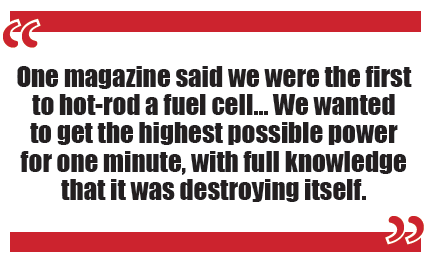
After three years of an intense powertrain engineering program to get every ounce of power possible, the team was able to make the city bus fuel cell think it was a race car. Originally designed to do 70 mph, in 2009 the VBB2’s powertrain pushed the car to a new world record for fuel cells at 302.877 mph.
With another record under its belt, the team went back to the drawing board. “In 2009, we found ourselves in the same kind of place we were in 2005,” explained Cooke. “The car had done what it could do. We asked ourselves, ‘If we build a whole new fuel cell car, what could we do to advance the technology?’ The answer was that we’d pretty much be doing the same thing, with some small tweaks and minor upgrades.”
The team found that while they were working on fuel cells for four or five years, Li-ion batteries had come a long way. Lithium technology went from a dream future technology to a viable option. Li-ion batteries were still expensive, but were available in larger formats for the first time, with power characteristics that were good for racing.
VBB2.5
Along with Li-ion technology, a lot of progress had been made in motor and inverter systems. In late 2009, the students decided to start designing a new ground-up battery-powered speed demon, with all the latest and greatest in powertrain technology.
At that time, Ohio State had a new group of students and researchers who hadn’t worked on the first generation battery-powered BB1. As a stepping stone to a brand new build, they decided to use VBB2’s platform, rip out all the hydrogen components and begin testing new batteries in it. “We said, before we try to build the ultimate land speed car, let’s try to improve our skills,” explained Cooke. “We went back to the Bonneville Speedway in 2010 with the same car, but with a new motor, inverter, batteries and control system in it. We dubbed that car the VBB2.5. It was really just a test platform.”
Land speed racing records are governed by different organizations, and there are many different classifications. The team was able to pitch VBB2.5 to new sponsors because the original battery-powered BB1 only set the US record, not the world record, which has racing trials held at a different event.
The world record for a battery electric vehicle was still only about 240 mph. The Ohio State team took that to sponsors and said, “Give us a year of expensive testing, but a year that would help us really learn for the next car, and we can bring home a battery record with this test mule.” Sure enough, in 2010 the vehicle was able to set an FIA-sanctioned world record at 307.666 mph.
The students
Normally, most of Ohio State’s motorsport teams are made up of undergraduate students. But so many people have been involved with the VBB programs that the team now includes seven graduate students as well.
Six of those graduate students were rollovers from undergrad who “didn’t want to leave – a common theme around here,” said Cooke. Those students are required to develop a thesis on their section of vehicle design. At the moment, there is thesis development work in aerodynamics, control systems, modeling systems, data acquisition, suspension design, motor and inverter testing, and battery control systems and testing. The seven students are working on eight papers. When they’re finished defending each thesis, in about two years, the plan is to compile them into a very detailed 1,000-page-plus book on the design and development of the VBB3.
VBB3 and the Four Club
“When we sat around the room and did the ‘what’s next?’ thing, we thought, ‘we have all these records, where do we go from here?’” said Cooke. “We were proud of what we had done, but the context in the press is always, ‘Wow, that’s really fast for a student group’ or ‘Wow, that’s fast for an EV.’ So the question in the room was: ‘What will it take to be really fast, period?’”
In land speed racing, the first digit tends to be the most important. If you go 299 mph you’re in the “Two Club.” One mph higher and you’re in the Three Club. Naturally, the ambitious Buckeyes set their sights on the Four Club.
“The answer is that all the fastest guys in the world have broken 400 mph,” explained Cooke. “The Four Club is what we wanted to get into. It’s about 80 mph faster than what we did before, so we went to the drawing board to see what that would take.”
A 300 mph car is a fast car, and takes a lot of power. But if you look at vehicles that break 300 mph, you find that they’re usually using production-type parts pushed to their limits and integrated in special ways. That’s generally true for all types of powertrains – gas, electric, everything. When you get up to the 400 mph barrier, the parts have to be custom. “You don’t go to a hot-rod shop, buy a V8 and tune it differently,” said Cooke. “Typically you’re building your own powertrain to do exactly what you need. The same is true in the electric world.”
The team’s idea was to fill up whiteboards with everything learned from previous years, take mental notes of it all, then wipe the boards clean and start fresh. Every component of the VBB3 vehicle was going to have to be new and optimized for the mission.
From 2010 to late 2012, they spent their time designing components and doing system-level testing to find out how the parts would interact. “We told our team, ‘Take the best parts that are off-the-shelf. Look at the spec sheet to note what it says, then throw it away and test the heck out of them to see where they actually fail.’ It’s not until we understand how things break that we understand what we need to do to make them better,” said Cooke.
Ohio State’s main partner, Venturi Automobiles, is closely involved with development, and it’s primarily responsible for the motor and controller. Venturi is a French company that’s interested in innovative designs and projects that dispel false perceptions about EVs – things like range, charging and speed limitations. It’s involved with many different races and demonstrations around the world that display just how capable EVs can be.
As the manufacturer for the motor and drive for the VBB3, Venturi worked with Ohio State to develop a custom configuration: two permanent-magnet AC motors end-to-end on a common shaft with a special cooling system that integrates both motors. Each axle has a dual-motor system currently capable of about 1,000 hp, and the team thinks there is room to improve up to about 1,400 hp. “The eventual goal is just over 1 MW of power on each axle, which is about 1,400 hp,” said Cooke. “The big challenge for this car is that we’ve gone to a tremendous amount more power than we’ve ever worked with. We were at the point on the previous vehicle where we were starting to slip the front wheels with so much torque. When you’re at the traction limit on an axle, the only thing you can do to get more power to the ground is start to power the other axle, so this is our first 4-wheel drive car.”
VBB3 has some unique power requirements: it uses a huge amount of energy in a one-minute-long sprint. This falls into a weird area between the capabilities of supercapacitors and batteries. “Battery companies said, ‘You want to extract all the energy in one minute? That’s a supercap.’” Cooke explained. “But then the supercap guys said, ‘We can give you that energy for 10 seconds. A minute is forever. Go talk to the battery guys.’”
The battery packs the team chose for the VBB3, which are designed to deliver that staggeringly high 1 MW of power to each axle, use cells from A123 with a very specialized chemistry. They’re not A123’s regular production cells – in fact, this is the first test application for the new technology, which has “amazing power characteristics.”
The entire capacity of the on-board batteries is about 90 kWh. The system is designed to use every bit of energy possible, because any that remains in the batteries at the end of the run is, essentially, extra weight. “We could go buy tons of lithium cells from a lot of different companies that have really good characteristics,” said Cooke. “But the problem is that the highest discharge rates usually allow 10 C or 20 C, meaning 4 or 5 minutes is the fastest you could extract all of the energy from those batteries. No matter what size it is, you can’t take it to empty in a minute. That’s what’s really special about the A123 cells we’re using – they let us drain the battery to the minimum state-of-charge really quickly, meaning the weight that we have on-board is useful.”
Lithium-ion batteries have a really flat voltage curve, which means the voltage is relatively steady until the upper and lower state-of-charge limits. The problem for this vehicle is that in the last 10 to 15 percent state-of-charge, the voltage falls off a cliff, and the end of the run is when the highest voltage is needed to produce maximum motor power. “We don’t want to be in that last 10 to 20 percent for performance reasons,” said Cooke. “So, we only discharge these batteries to about 80 percent.”
Another big challenge for the design team is the complexity of all the interacting systems. The previous vehicles each had one battery pack, or fuel cell unit, one motor and one drive. On the VBB3, the batteries are split into eight different packs, because of the power levels, which feed four different inverters driving four motors. There is one supervisory controller communicating with all the different sub-system controllers to balance and manage their interactions. “There is a lot of tweaking and tuning and making sure everything plays well together,” said Cooke.
Recruiting pipeline
In addition to really fast cars, Ohio State’s intense research projects also churn out top-quality engineering graduates.
“Instead of design projects ending only in white papers, we go out and build it, test it and solve problems,” said Cooke. “The result is that you get some pretty useful students that have hands-on experience making things that have to work. It is a missing component from a lot of the educational tracks.”
As a result, Ohio State’s partnerships with industry sponsors are a two-way street. The motorsport teams gain access to top-notch products and funding, while the sponsors build relationships with some of the brightest new recruits.
“One of the best ways we’ve been able to build our internal team is by forming relationships with organizations like The Ohio State University,” Chadwick Taylor told Charged. Taylor is a Senior Manager of Business Development for Hybrid and Electric Mobility Solutions at TE Connectivity, a sponsor of VBB3. “It’s a great pipeline for recruiting, and, at the same time, we’re able to utilize their resources as a research institution to help make TE products better.”
In the electric and hybrid industry, there is a very real need for more qualified engineering talent. “The players in [the EV Industry] are very focused on expanding their skillsets,” said Ajay Bhargava, Senior Manager and Global Product Line Manager for Electric and Hybrid Vehicles at TE Connectivity. “The players in this segment are now making long-term commitments, and you need a pipeline of engineers and engineering teams that understand the high-voltage products, just not the low-voltage products. In addition, this knowledge needs to be transferred across the organization – not just a few engineers within a functional group.”
“The auto industry is definitely changing, and it’s for the better,” added Taylor. “Now the OEMs want electric and hybrid powertrains to be offered as an option, rather than a niche standalone vehicle. That’s driving components to be smaller and less expensive, and that all comes from innovation on the engineering team. We can see that all the OEMs, and their top suppliers, are trying to attract the best talent to help drive the market in that direction.”
In addition to helping the Ohio State team with high-voltage connectors and contactors, TE supplies parts for the Chevrolet Volt, Ford Focus Electric, Fiat 500E, Tesla and EVs from “other German and Japanese automakers.” Initially focused on handling higher voltage and higher currents, the company has now diversified its product family to cover anything from mild hybrids to full/plug-in hybrids to BEVs. “Our goal was to have off-the-shelf products for all customers,” said Bhargava.
400 and beyond
In 2013, after two years of design and testing, the team assembled the VBB3 under a very tight schedule to make it in time for the short Bonneville racing window that happens every year in late summer.
“A few of the key components either had technology changes at the last second or delays,” said Cooke, “but we were ready to give things a first try. Unfortunately, the weather did not cooperate with us. When we got to Utah, the flats were flooded. They had hoped it was going to dry up, and thought it could. But it was unprecedented territory to have such a large amount of rain at that time of year. In the end we never made it onto the salt. We spent the week at a local airport and continued to test and tune the vehicle, running up to 100 mph on the runways.”
The team is signed up and preparing to head to the Bonneville Raceway where they will attempt the FIA world record in late August or early September 2014. After last summer the vehicle was stripped to its bare bones to make a variety of changes and improvements. This spring it will come together and begin testing. So far, the VBB3 has gone about 100 mph during shakedown runs on test tracks. That’s not impressive in terms of racing numbers, but necessary to work out the bugs in such a complex system.
“Now that everything is designed and built, the big story going forward in 2014 is getting it to come to a common mission and work safely and reliably,” said Cooke.
Will the student-built speed racer reach 400 mph this year? Perhaps the better question is: When the Venturi Buckeye Bullet does enter the Four Club, what’s next?
This article originally appeared in Charged Issue 13 – APR 2014







